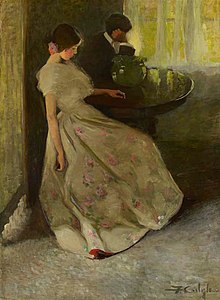Florence Carlyle
Florence Carlyle | |
|---|---|
 Florence Carlyle, c. 1890. | |
| Born | 1864 Galt, Ontario, Canada |
| Died | May 2, 1923 (aged 58–59) Crowborough, England |
| Nationality | Canadian |
| Known for | Painting |
| Partner(s) | Juliet Hastings[1] |
Florence Emily Carlyle (September 24, 1864 – May 2, 1923) was a Canadian figure and portrait painter, known especially for her handling of light and fabric, and for painting with great skill.[2] Her work is included in the collection of the National Gallery of Canada.[3]
Childhood[]
Florence Carlyle was born September 24, 1864, in Galt, Ontario,[1] to parents Emily Youmans Carlyle and William Carlyle.[4]:9–11 The second eldest of seven children, Florence was known throughout her life as "Bird" by family and friends.[5] In 1871 the Carlyle family moved to Woodstock, Ontario, where her father, William Carlyle, worked as the county inspector of schools for Oxford County.[6][4]:11 While living in Woodstock, Emily created an art studio for local children who were interested in developing their artistic skills under the guidance of hired artists.[4]:13 Sensing her daughter's artistic talent, Emily arranged for Florence to have private drawing and painting lessons with William Lees Judson.[4]:13 William's uncle (and Florence's great-uncle) was the Scottish historian and philosopher Thomas Carlyle;[7] and William was said by a contemporary writer to have inherited "much of the cleverness and the abstraction" of his celebrated forebear.[8]
Early adulthood[]
In 1883 Florence and her younger sister, Lilian, exhibited several of their works at the Ladies Department of the Toronto Industrial Exhibition.[4]:22 It was this exhibition that gave Florence widespread recognition as Princes Louise and her husband, the Marquis of Lorne purchased one of her paintings of white lilies on china.[4]:23 This event was heavily covered by The Globe, Daily Mail, and Woodstock's paper at the time.[4]:23
Education while in Paris[]

After realizing that she needed to go abroad to further develop her artistic skill, 26 year old Carlyle moved to Paris, France November 3, 1890.[4]:36 Carlyle journeyed to Paris with her artistic mentor, Paul Peel, his sister Margaret Peel, and their father John Peel. However, once in Paris she rented a flat on her own.[4]:36��� Upon first arriving in Paris, Carlyle found it difficult to find an artistic academy that admitted women and furthermore, did not segregate men and women in classes.[4]:42 At first Carlyle attended the Académie Julian, but after a disagreement with Adolphe-William Bouguereau she switched to the less prestigious Académie Delécluse.[4]:43 By 1892 Carlyle would return to Académie Julian to finish her studies.[4]:43 In 1893 she exhibited her painting Une Dame Hollandaise at the Salon of the Société des Artistes Français, where it "received favourable attention."[4]:54–56 Carlyle returned to Woodstock, where her family still resided in 1896.[4]:69
Later years[]
She had studios in London and Woodstock, and in 1897 became the first woman to be elected an Associate of the Royal Canadian Academy. In 1899, she established a studio in New York City.[10] In 1904, her oil painting The Tiff was selected to appear in the Canadian exhibition at the Louisiana Purchase Exposition, where it won a silver medal.[11]:85 The Montreal Gazette described this painting (now in the permanent collection of the Art Gallery of Ontario)[9] as "a strong piece of work depicting a lover's quarrel", and praised its execution as "clear cut and decisive."[12]
The last twenty years of her life were spent in Crowborough, Sussex, England, where she and a friend, Juliet Hastings, bought an English cottage they called "Sweet Haws".[13]
Carlyle died at Crowborough in the spring of 1923. Most of her work is in the collection of the Woodstock Art Gallery in Woodstock, Ontario.
References[]
- ^ Jump up to: a b McGirr, Katelyn. "Florence Carlyle An Artist Biography". RiverBrink Art Museum Blog. Archived from the original on 29 July 2017. Retrieved 29 July 2017.
- ^ Murray 2004, p. 11.
- ^ "Florence Carlyle".
- ^ Jump up to: a b c d e f g h i j k l m n Butlin, Susan (2009). The Practice of her Profession: Florence Carlyle, Canadian Painter in the Age of Impressionism. Kingston, ON: McGill-Queen's University Press. ISBN 9780773535091.
- ^ Murray 2004, p. 17.
- ^ Murray 2004, p. 20.
- ^ Campbell, Claire (Spring 2010). "Review of The Practice of Her Profession: Florence Carlyle, Canadian Painter in the Age of Impressionism" (PDF). Journal of Historical Biography. 7: 182–185. Archived (PDF) from the original on 2014-03-27. Retrieved 2017-08-28.
- ^ Murray 2004, p. 19.
- ^ Jump up to: a b "Florence Carlyle's The Tiff". AGO Art Gallery of Ontario. Retrieved 2020-10-01.
- ^ Farr, Dorothy; Luckyj, Natalie (1975). From Women's Eyes: Women Painters in Canada. Kingston: Agnes Etherington Art Centre. p. 26.
- ^ Murray 2004, p. 10.
- ^ "Art exhibition: Annual display of Royal Canadian Academy opens at the art gallery". The Gazette. 1904-03-18. p. 6. Retrieved 2020-10-01.
- ^ Murray 2004, p. 33.
Bibliography[]
- Murray, Joan (2004). Florence Caryle: Against All Odds. London and Woodstock: Museum London and the Woodstock Art Gallery. Retrieved 2021-03-22.
- Bruce, Tobi; Cable, Patrick Shaw (2011). The French Connection: Canadian Painters at the Paris Salons 1880-1900. Hamilton, Ontario: Art Gallery of Hamilton. Retrieved 2021-04-15.
External links[]
- Florence Carlyle at ArtNet, retrieved on May 25, 2007.
- 1864 births
- 1923 deaths
- Canadian women painters
- People from Crowborough
- Alumni of the Académie Julian
- 19th-century Canadian painters
- 20th-century Canadian painters
- 19th-century Canadian women artists
- 20th-century Canadian women artists
- Académie Delécluse alumni